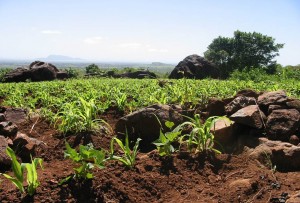Soil Quality, Soil Fertility & Low Productivity
Soil Quality, Soil Fertility & Low Productivity

Historically, farmers in much of Africa were able to maintain their soil quality and soil fertility through the use of long fallows of 10 to 20 years. Increasing population density, commercialization of agriculture, and property rights changes have all contributed to continuous cropping and shorter fallow periods, resulting in diminished soil quality and soil fertility. While soil quality is broadly defined as the capacity of the soil to function, soil fertility is defined more narrowly as the presence of adequately available plant nutrients. The two concepts are interrelated.
Problems with soil fertility can typically be quickly addressed with inputs, whereas improving soil quality is generally a long-term process. This difference in the time to realize benefits at least partially explains why many farmers request help obtaining inorganic fertilizers and why politicians have found it worthwhile to subsidize them. In contrast, strategies that build soil quality by building soil organic matter and soil aggregates are often neglected in part because farmers do not receive immediate, substantial benefits. However, neglecting soil quality issues eventually results in an inability to effectively improve soil fertility. Importantly, soils with very low soil quality are unable to use fertilizers efficiently. Farmers can become stuck in a downward cycle of reduced soil quality, resulting in fields that are less productive and unresponsive to short-term soil fertility improvements.
Further, maize is the dominant crop in many parts of the continent and adequate fertilizer or manure use is rare due to high costs. The result is low maize yields that further diminish farmers’ abilities to invest in soil fertility measures. Compounding the problem, with declining yields there is less organic matter being returned to the soil and this, combined with continuous cultivation, causes the soil quality to further decline, as evidenced by a loss of water and nutrient holding capacity.
Yet, another challenge is the tremendous diversity of soil conditions across sub-Saharan Africa. Not only are there diverse soil types, soil textures, cropping systems and categories of farmers, but there is increasing evidence that in many contexts farmers manage soil fertility differently from one plot to the next. Some farmers choose to invest their resources in their best plots to make them even more productive while their worse plots may degrade further.
The Global Change Learning Lab is actively researching techniques that allow farmers to build up the soil and meet their production goals without sacrificing soil quality over the long-term. For example, practices that use legumes as green manures or in rotation can help provide lacking nitrogen while improving aggregation, enhancing the environment for beneficial microbial populations, and strengthening the resilience of the farming system.
The Snapp Lab is investigating the following promising options:
- Doubled Up Legumes
- Legume Best Bets
- Mother & Baby Trial Design
- Multipurpose Legumes for Soil Rehabilitation
- Nitrogen- It’s What’s for Dinner
- Participatory Research and Action Learning
- Perennial Grains
- Phosphorus- the Key to Sustainable Nutrient Management
- Pigeon Pea- Hydraulic Lift
- Sustainable Intensification
- Sustainable/Ecological Weed Management
